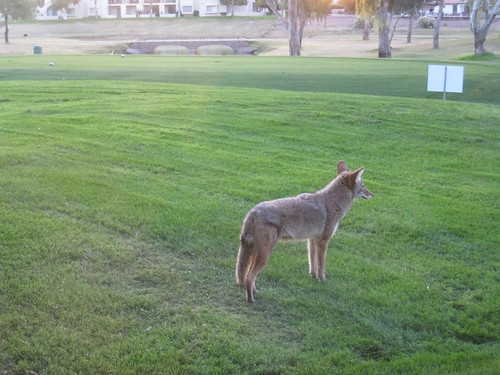
In defense of the urban coyote
by Matt Howatt
They have adapted to urban life and survived near the top of the urban food chain mostly out of sight and out of mind for decades. But all eyes are on urban coyotes this week after a chihuahua was plucked from the backyard of a home in the Beaches area of Toronto by an allegedly “brazen†coyote.
This weeks coverage of the attack on the Toronto Star’s website incited passionate debate and generated more comments than many other stories in the news with 60 to 70 per story. The coyote attack has served as a catalyst for debate over a myriad of issues from the rural-urban divide and gun control in cities to proper parenting skills and the need for domesticated pets. Pitbull owners question why their dogs are banned while coyotes roam freely and fence builders are proclaiming the qualities of a well-built fence.
The thought of mammalian carnivores such as the coyote living amongst us in the city is both thrilling and frightening for many. Coyotes resemble many of the domesticated dogs that chase tennis balls in local parks and excitedly greet guests at the front door, but they are not. They are not bound by familiar collars and leashes and they rely on instincts and refined skills to survive. Coyotes represent a wild side of the city that survives with a resilient and adaptive nature.
The comments of online Star readers have ranged from unsympathetic farmers who see a clear problem and solution (got a coyote? grab your rifle and a shovel), to anti-consumerists and naturalists who ponder if those petitioning to have the coyotes removed are the same people who pile into their SUVs dressed in high-priced active wear and guzzle gas all the way up the 400 highway to get back nature. Others have proclaimed this to be a normal occurrence in a wilderness country like Canada and decried any type of American response to grab a gun and head into the woods.
Another issue is the possibility that the Beach coyote’s apparent disregard for humans signals it may be a “coydog†— a hybrid combining the fierce hunting abilities of a coyote with the familiarity and attraction to humans possessed by dogs. Messages of condolence to the family who lost their dog are mixed with the “strongest will survive†comments that label the chihuahua as natural coyote food.
The argument that coyotes should be left alone because “they were here before us†as many of the comments on the Star’s website have stated does not give credit to their unique adaptive abilities. It is believed that coyotes arrived in the area around 100 years ago after development had begun in many city centres. According to the 2007-2008 report from Ontario’s Environmental Commissioner coyotes quickly adapt to human-caused alterations to the landscape such as the clearing of land for agriculture or development. They’ve basically followed the path of human development for its provision of open fields, wood lots and ravines along with the livestock, rodents and food waste provided by human activity. The report estimates approximately 4,600 coyotes were hunted or trapped last year in Ontario while their population remains “abundantâ€.
Conversely, the argument to remove coyotes from urban environments fails to recognize the coyotes roll in controlling the population of rodents and feral cats in cities. In addition, their presence provides opportunities for education and awareness of the complex urban ecosystems thriving in our park systems, along our infrastructure corridors and across vast tracts of disused industrial areas. For example, Vancouver’s Stanley Park Ecology Society implemented a Co-Existing With Coyotes Program that seeks to educate the public and provide school curriculum about coyotes in addition to tracking coyote sightings on its website.
As the City of of Toronto strives to establish its City Within A Park image, it must manage the urban ecosystem it supports. Toronto’s system of ravines, valley parks and tracts of naturalized industrial areas make life comfortable for the commuting coyotes who may traverse across the city via hydro corridors, highways and the cities extensive green network. It’s late winter and the lure of food waste, pet food and the rodents it attracts, as well as household pets, are food opportunities for the coyote that has been scrounging for mice under the snow since December. Residents must recognize their position in the urban ecosystem and the vulnerability of small pets. The City’s first step in managing urban coyotes should be to have its citizens keep their garbage secure and their pets in sight.
Incidents like the Beaches coyote attack will hopefully spur discussion and action to balance the necessity of both safe communities and vital urban ecosystems.
– – – – – –
Matt Howatt is a fourth-year student at Ryerson in the Urban and Regional Planning program. He lives in Burlington where coyote sightings are common.
photo by Dru Bloomfield


20 comments
“[…] the coyotes roll in […]”
Now there’s a site to see.
You raise interesting questions. As cities trend towards naturalization, and in Toronto’s case “City Within A Park,” the place of faunal wild life will become increasingly important.
it is a mistake for Star commenters so write that the American response is to grab a gun. Coyotes are residents of LA and dog-owners warn each other when coyotes are spotted nearby. No one is reaching for their pistol, tho.
More coyotes, fewer chihuahuas seems like win-win to me.
I’d love to see an episode of Planet Earth that was dedicated to urban ecosystems and followed a coyote, a pidgeon and a rat. I’m sure there are all types of creatures that we just never see.
Do they eat Raccoons? If so, can I lease a coyote for 1-2 weeks?
Owners of chihuahuas (or any small pets) must watch their animals carefully in the first place…
I have a pug which I walk off-leash in High Park where coyotes have returned after a few-years’ absence. Apparently, a pack of three has been spotted at the south end of the Park. I make sure to keep the pug with me as much as possible.
Aside from coyotes, raccoons or even falcons can “pluck” up a small un-supervised animal for a tasty snack.
Interesting article on the whole, but I agree with the commenter from LA: There’s no need to (thoughtlessly?) lump Americans into some kind of gun-totin’ posse.
So some people call Toronto the “City Within A Park”? I never heard that before even though I’ve been here half my life. That’s great and it should be our motto. What ever happened to all that Toronto Inc. business? That was terrible. So boring. “City Within A Park” is great! With the growth of organizations like Evergreen I think we could really develop that idea. And it would truly legitimize urban wildlife like those amazing coyotes.
Kristin: “the City Within a Park” is on every park sign in the city.
See it in action here:
http://flickr.com/photos/wikisauga/2361990162/
And the campaign you are refrring to was called Toronto Unlimited, not Inc.
http://torontounlimited.ca/
http://www.toronto.ca/unlimited/index.htm
“City Within a Park” is an apt motto for us. It reminds us that Toronto is happily blessed with a location where continental forests (like the Carolinian) converge and High Park features the last Black Oak Savannah on the planet. Toronto’s tree-canopy covers 20% today while the City target is to reach 35%.
Excuse the digression from the Blog, but it’s kind of relevant information when discussing urban wildlife and migration…
Great info Gabe, especially this Black Oak Savannah. Where is it in the park? north-west area?
Thanks.
“City Within a Park” is pretty lame, no?
No.
Yes. “Within” is an awkward word for a slogan. If we’re going to insist on being a city in a park, let’s just say “Toronto: City in a Park”.
Matt H: great piece! I think you’ve reminded us all about how important it is that we too adapt to our ecosystems (urban or otherwise).
wrt to the black oak savannah, there are others (e.g. Alderville ON) but they are certainly endangered. If you want to visit, this notice from the City shows the location: http://www.toronto.ca/trees/pdfs/HPfactsheet.pdf
High Park has a great volunteer organization that coordinates stewardship activities (http://www.highpark.org/vsp.htm) if you are interested in learning more.
Great article.
In Vancouver, one is quite used to these urban critters. I think it is more of an east coast thing to be all freaked out by the signs of wildlife. We had a baby snatched by a coyote in West Van, caused a bit of a stir. The people here in Montreal really crap their pants when they even see a raccoon.
Great Case Study. Establishing urban ecosystems will be an important part in regenerating our environment.
I saw Neville for the first time late last summer, and actually mistook him for a particularly giant fox due to his red coat(a few have lived in the ravine for years). I was walking along Queen, close to the Fox Theater around 2:30 in the morning, as the garbage was being picked up, and he trotted casually along the sidewalk, totally ignoring the garbage men and I, a half chicken dangling from his mouth.
Clearly, at night, Queen St. E. was his domain.
I have seen plenty of Coyotes around the denver Metro area and consider them a treasure and a reminder of the wild. great article!
I just saw a coyote leaving my film set on Unwin Ave Toronto , the Old Hearn factory . he ambled past my car then crossed in front of it and into the bushes. I thouhght I was crazy and then found the news